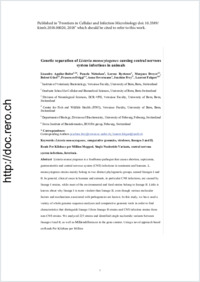Genetic separation of Listeria monocytogenes causing central nervous system infections in animals
- Aguilar-Bultet, Lisandra Swiss Institute of Bioinformatics (SIB), Switzerland - Institute of Veterinary Bacteriology, Vetsuisse Faculty (Veterinary Medicine), University of Bern, Switzerland - Graduate School for Cellular and Biomedical Sciences, University of Bern, Switzerland
- Nicholson, Pamela Institute of Veterinary Bacteriology, Vetsuisse Faculty (Veterinary Medicine), University of Bern, Switzerland
- Rychener, Lorenz Institute of Veterinary Bacteriology, Vetsuisse Faculty (Veterinary Medicine), University of Bern, Switzerland
- Dreyer, Margaux Graduate School for Cellular and Biomedical Sciences, University of Bern, Switzerland - Division of Neurological Sciences, DCR-VPH, Vetsuisse Faculty (Veterinary Medicine), University of Bern, Switzerland
- Goezel, Bulent Graduate School for Cellular and Biomedical Sciences, University of Bern, Switzerland - Division of Neurological Sciences, DCR-VPH, Vetsuisse Faculty (Veterinary Medicine), University of Bern, Switzerland
- Origgi, Francesco C. Center for Fish and Wildlife Health (FIWI), Vetsuisse Faculty (Veterinary Medicine), University of Bern, Switzerland
- Oevermann, Anna Division of Neurological Sciences, DCR-VPH, Vetsuisse Faculty (Veterinary Medicine), University of Bern, Switzerland
- Frey, Joachim Institute of Veterinary Bacteriology, Vetsuisse Faculty (Veterinary Medicine), University of Bern, Switzerland
- Falquet, Laurent Swiss Institute of Bioinformatics (SIB), Switzerland - Dept of Biology, University of Fribourg, Switzerland
-
2018
Published in:
- Frontiers in Cellular and Infection Microbiology. - 2018, vol. 8, p. 20
English
Listeria monocytogenes is a foodborne pathogen that causes abortion, septicemia, gastroenteritis and central nervous system (CNS) infections in ruminants and humans. L. monocytogenes strains mainly belong to two distinct phylogenetic groups, named lineages I and II. In general, clinical cases in humans and animals, in particular CNS infections, are caused by lineage I strains, while most of the environmental and food strains belong to lineage II. Little is known about why lineage I is more virulent than lineage II, even though various molecular factors and mechanisms associated with pathogenesis are known. In this study, we have used a variety of whole genome sequence analyses and comparative genomic tools in order to find characteristics that distinguish lineage I from lineage II strains and CNS infection strains from non-CNS strains. We analyzed 225 strains and identified single nucleotide variants between lineages I and II, as well as differences in the gene content. Using a novel approach based on Reads Per Kilobase per Million Mapped (RPKM), we identified 167 genes predominantly absent in lineage II but present in lineage I. These genes are mostly encoding for membrane-associated proteins. Additionally, we found 77 genes that are largely absent in the non-CNS associated strains, while 39 genes are especially lacking in our defined “non-clinical” group. Based on the RPKM analysis and the metadata linked to the L. monocytogenes strains, we identified 6 genes potentially associated with CNS cases, which include a transcriptional regulator, an ABC transporter and a non-coding RNA. Although there is not a clear separation between pathogenic and non-pathogenic strains based on phylogenetic lineages, the presence of the genes identified in our study reveals potential pathogenesis traits in ruminant L. monocytogenes strains. Ultimately, the differences that we have found in our study will help steer future studies in understanding the virulence mechanisms of the most pathogenic L. monocytogenes strains.
- Faculty
- Faculté des sciences et de médecine
- Department
- Département de Biologie
- Language
-
- English
- Classification
- Biological sciences
- License
-
License undefined
- Identifiers
-
- RERO DOC 306700
- DOI 10.3389/fcimb.2018.00020
- Persistent URL
- https://folia.unifr.ch/unifr/documents/306279
Statistics
Document views: 104
File downloads:
- pdf: 156
